#sergio ruggeri
Explore tagged Tumblr posts
Text




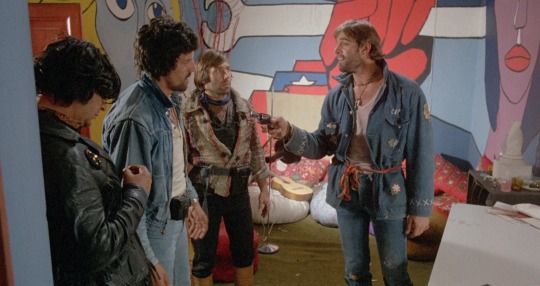
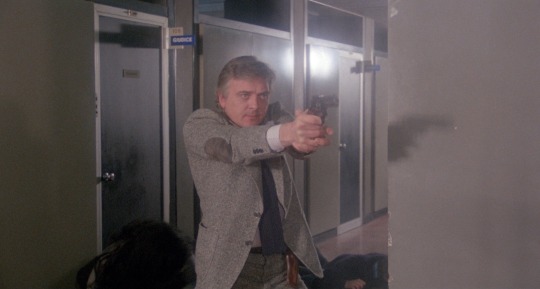



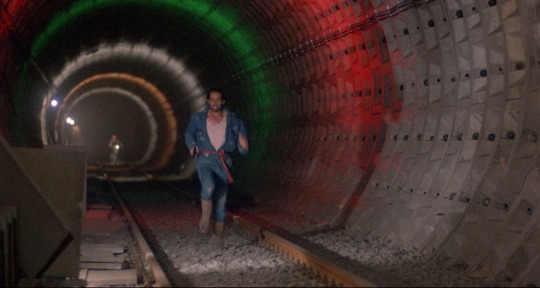
La via della droga (The Heroin Busters, 1977)
"Listen... it's getting very hard for me to cover for you."
"Yes, I know. Don't worry about it. It's my life, after all."
#la via della droga#the heroin busters#italian cinema#poliziotteschi#1977#enzo g. castellari#galliano juso#massimo de rita#fabio testi#david hemmings#sherry buchanan#wolfango soldati#massimo vanni#angelo ragusa#romano puppo#joshua sinclair#sergio ruggeri#gianni orlando#leonardo scavino#salvatore billa#goblin#director Castellari and star Testi had previously collaborated on 76's Big Racket‚ one of the most impressive and high octane of the glut#of poliziotteschi to flood the Italian market in the latter half of the 70s. alas this is no Big Racket. it's fine‚ dumb and explosive in#its own way‚ but there isn't enough spectacle nor enough originality to make it stand out from other examples of the genre#that being said‚ there's enough here for the Testi fangirls (guilty) as he spends the majority of the film sweaty and dishevelled and#in the cutest double denim and thigh high boots fit perhaps ever seen on an Italian leading man. Hemmings lends easygoing support#here during his european extended working holiday period‚ but if anything steals focus here then it's perhaps naturally the#goblin score‚ a delightful bit of fuzzy prog warbling which truth be told probably belongs in a slightly better film#edit: ok i looked at the images and the boots are clearly not thigh high.. what a Testi fit can do to the unconscious mind..
8 notes
·
View notes
Text
Vorrei fabbricarti
una casetta in centro con le mani
0 notes
Text
Argentina FIFA World Cup XI
Ubaldo Fillol - Goal Keeper - River Plate (Argentina)
Alberto Tarantini - Left Back - River Plate (Argentina)
Daniel Passarella - Centre Back - River Plate (Argentina)
Luis Galván - Centre Back - Talleres (Argentina)
Gonzalo Montiel - Right Back - Sevilla (Spain)
Américo Gallego - Defensive Midfielder - Newell’s Old Boys (Argentina)
Enzo Fernández - Central Midfielder - River Plate (Argentina)
Oswaldo Ardiles - Central Midfielder - Tottenham Hotspur (England)
Diego Maradona - Attacking Midfielder - Argentinos Juniors (Argentina)
Lionel Messi (Captain) - Centre Forward - Barcelona (Spain)
Mario Kempes - Centre Forward - Valencia (Spain)
Substitution
Emiliano Martínez - Goal Keeper - Aston Villa (England)
Marcos Acuña - Left Back - Racing Club (Argentina)
Oscar Ruggeri - Centre Back - San Lorenzo (Argentina)
José Luis Brown - Centre Back - Estudiantes de La Plata (Argentina)
Jorge Olguín - Right Back - Argentinos Juniors (Argentina)
Sergio Batista - Defensive Midfielder - Argentinos Juniors (Argentina)
Héctor Enrique - Central Midfielder - Lanús (Argentina)
Alexis Mac Allister - Central Midfielder - Brighton & Hove Albion (England)
Ángel Di María - Attacking Midfielder - Paris Saint-Germain (France)
Leopoldo Luque - Centre Forward - River Plate (Argentina)
Julián Alvarez - Centre Forward - River Plate (Argentina)
Manager
Lionel Scaloni - Argentina - Argentina National Football Team
Argentina FIFA World Cup XI 5-A-Side
Ubaldo Fillol - Goal Keeper - River Plate (Argentina)
Daniel Passarella - Defender - River Plate (Argentina)
Luis Galván - Defender - Talleres (Argentina)
Lionel Messi (Captain) - Forward - Barcelona (Spain)
Mario Kempes - Forward - Valencia (Spain)
Substitution
Emiliano Martínez - Goal Keeper - Aston Villa (England)
Oscar Ruggeri - Defender - San Lorenzo (Argentina)
José Luis Brown - Defender - Estudiantes de La Plata (Argentina)
Leopoldo Luque - Forward - River Plate (Argentina)
Julián Alvarez - Forward - River Plate (Argentina)
Manager
Lionel Scaloni - Argentina - Argentina National Football Team
Argentina FIFA World Cup XI 6-A-Side
Ubaldo Fillol - Goal Keeper - River Plate (Argentina)
Daniel Passarella - Defender - River Plate (Argentina)
Luis Galván - Defender - Talleres (Argentina)
Américo Gallego - Midfielder - Newell’s Old Boys (Argentina)
Lionel Messi (Captain) - Forward - Barcelona (Spain)
Mario Kempes - Forward - Valencia (Spain)
Substitution
Emiliano Martínez - Goal Keeper - Aston Villa (England)
Oscar Ruggeri - Defender - San Lorenzo (Argentina)
José Luis Brown - Defender - Estudiantes de La Plata (Argentina)
Sergio Batista - Midfielder - Argentinos Juniors (Argentina)
Leopoldo Luque - Forward - River Plate (Argentina)
Julián Alvarez - Forward - River Plate (Argentina)
Manager
Lionel Scaloni - Argentina - Argentina National Football Team
Argentina FIFA World Cup XI 7-A-Side
Ubaldo Fillol - Goal Keeper - River Plate (Argentina)
Daniel Passarella - Defender - River Plate (Argentina)
Luis Galván - Defender - Talleres (Argentina)
Enzo Fernández - Midfielder - River Plate (Argentina)
Oswaldo Ardiles - Midfielder - Tottenham Hotspur (England)
Lionel Messi (Captain) - Forward - Barcelona (Spain)
Mario Kempes - Forward - Valencia (Spain)
Substitution
Emiliano Martínez - Goal Keeper - Aston Villa (England)
Oscar Ruggeri - Defender - San Lorenzo (Argentina)
José Luis Brown - Defender - Estudiantes de La Plata (Argentina)
Héctor Enrique - Midfielder - Lanús (Argentina)
Alexis Mac Allister - Midfielder - Brighton & Hove Albion (England)
Leopoldo Luque - Forward - River Plate (Argentina)
Julián Alvarez - Forward - River Plate (Argentina)
Manager
Lionel Scaloni - Argentina - Argentina National Football Team
1 note
·
View note
Text
ENGAGEDS FOR 2025
AARÓN ESCANDELL & LARA ALBELDA - Real Oviedo
ADRIÁN DE LA FUENTE & ALE BECKER - UD Levante
ALAN GODOY & ANA MARÍA - CD Eldense
ALEIX GARCIA & DENISA BUDAN - Bayer Leverkusen
ANDREA PETAGNA & CAROLINA MONTEFUSCO - AC Monza
ANDRÉS MARTÍN & NIRA ARTILES - Racing Santander
BORJA MAYORAL & FLAVIA NATALINI - Getafe CF
CARLO PINSOGLIO & HINDA EL MAHI - Juventus FC
DAVID RAYA & TATIANA TROUBOUL - Arsenal FC
EDU EXPÓSITO & INMACULADA E. - RCD Espanyol
FABIÁN RUIZ & ROSA PEREIRA - Paris Saint Germain
FERNANDO PACHECO & ÁNGELA GUERRERO - RCD Espanyol
FRAN NAVARRO & NATALIE RAMÍREZ - FC Porto
FRANCESCO ACERBI & CLAUDIA SCARPARI - Inter Milan
GIACOMO RICCI & MARTINA PARDINI - Cosenza Calcio
GIANLUCA SCAMACCA & FLAMINIA APOLLONI - Atalanta BC
GIANLUIGI DONNARUMMA & ALESSIA ELEFANTE - Paris Saint Germain
GIUSEPPE PRESTIA & DESIRÉE IMPICCINI - Cesena FC
GIUSEPPE SIBILLI & NOEMI URBANI - SSC Bari
ISI PALAZÓN & MARTA SORIANO - Rayo Vallecano
KIKE PÉREZ & IRENE RUIZ - Real Valladolid
LEONARDO CANDELLONE & ELISA FAINA - SS Juve Stabia
LUCA VIGNALI & CATERINA SCAMPELLI - Spezia Calcio
MATTEO GABBIA & FEDERICA RUGGERI - AC Milan
NICOLA DALMONTE & GAYA MURCIANO - US Salernitana
ORIOL BUSQUETS & MILI LAJE - FC Arouca
ÓSCAR PLANO & CRISTINA NOVELLA - Elche CF
ROLANDO MANDRAGORA & LUCIA PERSICO - ACF Fiorentina
SALVA FERRER & NEREA TOMÀS - Spezia Calcio
SERGIO BUSQUETS & ELENA GALERA - Inter Miami
UNAI NÚÑEZ & CYNTIA ROLDÁN - Athletic Club
0 notes
Text
youtube
National anthems of all FIFA World Cup champions (1974-2018) National anthems of all FIFA World Cup champions (1974-2018) Lineups : 🇩🇪 GERMANY 1974 - Sepp Maier, Berti Vogts, Franz Beckenbauer (c), Hans-Georg Schwarzenbeck, Paul Breitner, Rainer Bonhof, Wolfgang Overath, Uli Hoeneß, Jürgen Grabowski, Bernd Hölzenbein, Gerd Müller. 🇦🇷 ARGENTINA 1978 - Ubaldo Fillol, Jorge Olguín, Luis Galván, Daniel Passarella (c), Alberto Tarantini, Américo Gallego, Osvaldo Ardiles, Mario Kempes, Daniel Bertoni, Oscar Alberto Ortiz, Leopoldo Luque. 🇮🇹 ITALY 1982 : Dino Zoff (c), Gaetano Scirea, Claudio Gentile, Fulvio Collovati, Giuseppe Bergomi, Antonio Cabrini, Gabriele Oriali, Marco Tardelli, Bruno Conti, Francesco Graziani, Paolo Rossi. 🇦🇷 ARGENTINA 1986 : Nery Pumpido, José Luis Brown, José Luis Cuciuffo, Oscar Ruggeri, Ricardo Giusti, Julio Olarticoechea, Sergio Batista, Jorge Burruchaga, Héctor Enrique, Diego Maradona (c), Jorge Valdano. 🇩🇪 GERMANY 1990 : Bodo Illgner, Klaus Augenthaler, Guido Buchwald, Jürgen Kohler, Thomas Berthold, Andreas Brehme, Thomas Häßler, Lothar Matthäus (c), Pierre Littbarski, Rudi Völler, Jürgen Klinsmann. 🇧🇷 BRAZIL 1994 : Cláudio Taffarel, Jorginho, Aldair, Marcio Santos, Branco, Mauro Silva, Dunga (c), Mazinho, Zinho, Romário, Bebeto. 🇫🇷 FRANCE 1998 : Fabien Barthez, Lilian Thuram, Frank Leboeuf, Marcel Desailly, Bixente Lizarazu, Didier Deschamps (c), Christian Karembeu, Emmanuel Petit, Zinedine Zidane, Youri Djorkaeff, Stéphane Guivarc'h. 🇧🇷 BRAZIL 2002 : Marcos, Lúcio, Edmílson, Roque Júnior, Cafu (c), Gilberto Silva, Kléberson, Roberto Carlos, Ronaldinho, Rivaldo, Ronaldo. 🇮🇹 ITALY 2006 : Gianluigi Buffon, Gianluca Zambrotta, Fabio Cannavaro (c), Marco Materazzi, Fabio Grosso, Mauro Camoranesi, Gennaro Gattuso, Andrea Pirlo, Simone Perrotta, Francesco Totti, Luca Toni. 🇪🇸 SPAIN 2010 : Iker Casillas (c), Sergio Ramos, Gerard Piqué, Carles Puyol, Joan Capdevila, Sergio Busquets, Xabi Alonso, Xavi, Andrés Iniesta, Pedro, David Villa. 🇩🇪 GERMANY 2014 : Manuel Neuer, Philipp Lahm (c), Jérôme Boateng, Mats Hummels, Benedikt Höwedes, Christoph Kramer, Bastian Schweinsteiger, Thomas Müller, Toni Kroos, Mesut Özil, Miroslav Klose. 🇫🇷 FRANCE 2018 : Hugo Lloris (c), Benjamin Pavard, Raphaël Varane, Samuel Umtiti, Lucas Hernandez, Paul Pogba, N'Golo Kanté, Kylian Mbappé, Antoine Griezmann, Blaise Matuidi, Olivier Giroud. via YouTube https://www.youtube.com/watch?v=CIqIg19jZTY
0 notes
Video
Lea Padovani by Truus, Bob & Jan too! Via Flickr: Italian postcard by Nannina, Milano. Lea Padovani (1923-1991) was an Italian stage and film actress. She appeared in 60 films between 1945 and 1990. She starred in the French crime film Le Dossier noir/Black Dossier (André Cayatte, 1955) which was entered into the 1955 Cannes Film Festival. Lea Padovani was born in Montalto di Castro, in 1923. Against her father's advice, Lea enrolled at L'Accademia d'Arte Drammatica, the National Academy of Dramatic Art in Rome, which she left in 1944. She made her debut as a soubrette in Garinei and Giovannini's revue 'Cantachiaro'. The following year, she was part of Erminio Macario's company in 'Febbre azzurra'. She demonstrated excellent acting skills and enjoyed great success. Her meeting with Macario led to work in the film industry. She made her film debut with the female leading role in the comedy L'innocente Casimiro/The Innocent Casimiro (Carlo Campogalliani, 1946) starring Erminio Macario. In 1946 she began her long and successful career as a theatre actress with Armand Salacrou's 'Un uomo come gli altri' and with Jean Cocteau's 'I parenti terribili' in Luchino Visconti's Milanese revival. In 1953, she was alongside Ruggero Ruggeri on a tour to London and Paris with 'Enrico IV' and 'Tutto per bene'. In 1954 she was awarded a special Nastro d'Argento (Silver Ribbon award) for her theatrical performances. From 1947 Lea Padovani appeared in international films, such as Una lettera al Alba/Letter at Dawn (Giorgio Bianchi, 1948) and the British social drama Give Us This Day (Edward Dmytryk, 1949) with Sam Wanamaker. Orson Welles originally cast Lea as Desdemona in his 1952 film production of Othello back in 1948. After Welles began the filming in Venice, producer Montatori Scalera informed Welles that he wanted to make Verdi's opera, not the Shakespearean play, so the money ran out and the film was shelved. By the time the film was made years later, Lea had been replaced by Suzanne Cloutier. She starred in the French crime film Le Dossier noir/Black Dossier (André Cayatte, 1955) which was entered into the 1955 Cannes Film Festival. A big hit was the comedy Pane, amore e...../Scandal in Sorrento (Dino Risi, 1955) in which she co-starred with Sophia Loren and Vittorio De Sica. In the 1950s, Padovani also took part in several TV dramas, including Piccole done (Anton Giulio Majano, 1955), Il romanzo di un giovane povero (Silverio Blasi, 1957) and Ottocento (Anton Giulio Majano, 1959-1960). During the 1960s, the stage and television became more important than her film career. In 1990, she made her last film, La putain du roi/The King's Whore (Axel Corti, 1990) with Timothy Dalton and Valeria Golino. Shortly before her death, the actress told writer Renzo Allegri about her encounters with Padre Pio in the late 1950s, asking for help for one of her lovers, who was terminally ill with cancer. She died in 1991 of a heart attack. In 2006, director Oliver Parker directed the film Fade to Black, based on the novel Fade to Black by Davide Ferrario, inspired by a fictional story involving the actress, played in the film by Paz Vega, and the director Orson Welles, played by Danny Huston. In 2012, a theatre named after Lea Padovani was inaugurated in Montalto di Castro by Mayor Sergio Caci and Culture Councillor Eleonora Sacconi. Sources: Wikipedia (Italian and English) and IMDb. And, please check out our blog European Film Star Postcards.
#Lea Padovani#Lea#Padovani#Italian#Actress#Actrice#European#Film Star#Film#Cine#Kino#Cinema#Movie#Movies#Picture#Screen#Filmster#Star#Vintage#Postcard#Nannina#flickr
0 notes
Text
wm finale 1990 aufstellung
🎰🎲✨ Erhalten Sie 500 Euro und 200 Freispiele, plus einen zusätzlichen Bonus, um Casinospiele mit nur einem Klick zu spielen! ✨🎲🎰
wm finale 1990 aufstellung
Die deutsche Mannschaft trat im WM-Finale 1990 mit einer starken Aufstellung an, die von Trainer Franz Beckenbauer sorgfältig ausgewählt wurde. Dieses historische Endspiel fand am 8. Juli 1990 im Stadio Olimpico in Rom statt. Deutschland traf auf Argentinien und holte sich letztendlich den dritten Weltmeistertitel.
In der Startaufstellung der deutschen Mannschaft standen einige herausragende Spieler. In der Verteidigung hatten wir mit Jürgen Kohler und Guido Buchwald zwei solide Abwehrspieler, die ihre Positionen mit viel Erfahrung und Entschlossenheit verteidigten. Ergänzt wurden sie von Andreas Brehme und Klaus Augenthaler, die ebenfalls ihr Bestes gaben.
Das Mittelfeld war mit den talentierten Spielern Pierre Littbarski, Thomas Berthold, Lothar Matthäus und Andreas Möller besetzt. Dieses Quartett brachte viel Kreativität, Durchsetzungsvermögen und Torgefahr mit in das Spiel. Sie waren maßgeblich daran beteiligt, den deutschen Angriff anzufeuern und die entscheidenden Pässe zu spielen.
Im Sturm hatten wir mit Rudi Völler und Jürgen Klinsmann zwei echte Torgefährten. Ihre Geschwindigkeit und Durchsetzungskraft bereiteten der argentinischen Abwehr große Probleme. Dieses Duo war für die deutschen Tore im Finale von entscheidender Bedeutung.
Die deutsche Mannschaft zeigte im WM-Finale 1990 eine beeindruckende Leistung und bewies, dass sie als Team zusammenarbeiten konnte. Die Spieler brachten ihre individuellen Fähigkeiten ein und harmonierten sehr gut miteinander. Das Ergebnis war ein verdienter Sieg gegen Argentinien und der Gewinn des dritten Weltmeistertitels für Deutschland. Dieses historische Ereignis bleibt für immer in den Köpfen der deutschen Fußballfans verankert.
Das Finale der Fußball-Weltmeisterschaft 1990 war ein denkwürdiges Ereignis, das in die Geschichte eingegangen ist. In diesem Artikel beschäftigen wir uns mit den Spielerpositionen der beiden Finalisten, Deutschland und Argentinien. Diese beiden Mannschaften traten in einem packenden Spiel gegeneinander an, das mit einem 1:0-Sieg für Deutschland endete.
Die deutsche Nationalmannschaft, angeführt von ihrem Trainer Franz Beckenbauer, spielte in einem System, das als "Libero-Taktik" bekannt war. Das bedeutete, dass sie mit einem Libero spielten, der hinter der Abwehr agierte und die Mitspieler unterstützte. In diesem Fall war der erfahrene Lothar Matthäus der Libero. Die restliche Abwehrreihe bestand aus Jürgen Kohler, Klaus Augenthaler und Andreas Brehme.
Im Mittelfeld agierten Thomas Häßler, Andreas Möller, Guido Buchwald und Pierre Littbarski. Sie waren für die kreative Gestaltung des Spiels und den Spielaufbau verantwortlich. Insbesondere Häßler und Littbarski waren für ihre Dribbelstärke und ihren Torabschluss bekannt.
Im Sturm spielten die beiden Stürmer Rudi Völler und Jürgen Klinsmann. Sie bildeten ein starkes Angriffsduo, das für seine Schnelligkeit und Torgefahr gefürchtet war. Völler hatte einen besonderen Lauf bei dieser Weltmeisterschaft und erzielte im Finale den einzigen Treffer des Spiels.
Die argentinische Mannschaft unter Trainer Carlos Bilardo spielte in einem etwas offensiveren System. Sergio Goycochea im Tor wurde unterstützt von einer Abwehrreihe, die aus José Luis Brown, Oscar Ruggeri und Jorge Valdano bestand.
Im Mittelfeld agierten José Luis Cucciufo, Jorge Burruchaga, Ricardo Giusti und Diego Maradona als Spielmacher. Maradona, einer der legendärsten Spieler aller Zeiten, war für seine außergewöhnliche Technik und seine Führungskompetenz bekannt.
Im Sturm spielten Jorge Valdano und Claudio Caniggia. Sie waren für ihre Torgefahr und Schnelligkeit berüchtigt. Besonders Caniggia war im Turnierverlauf für seine entscheidenden Treffer bekannt.
Das Finale 1990 war eine spannende Begegnung zwischen zwei starken Mannschaften. Deutschland konnte letztendlich den Sieg erringen, aber beide Teams zeigten ihr Können auf dem Spielfeld und machten das Finale zu einem unvergesslichen Ereignis in der Geschichte des Fußballs.
Die Weltmeisterschaft im Jahr 1990 war ein denkwürdiges Ereignis für die deutsche Nationalmannschaft. Im Finale stand Deutschland der Mannschaft aus Argentinien gegenüber und beide Teams kämpften um den begehrten Titel.
Die Aufstellung der deutschen Nationalmannschaft für das Endspiel war von entscheidender Bedeutung. Unter der Leitung des Trainers Franz Beckenbauer wurden folgende Spieler in die Startelf berufen:
Bodo Illgner: Der Torhüter Illgner war ein wichtiger Bestandteil der deutschen Aufstellung. Mit seinen reflexartigen Paraden und seiner Ruhe auf dem Spielfeld konnte er entscheidende Tore der argentinischen Mannschaft verhindern.
Andreas Brehme: Brehme spielte als linker Verteidiger und war ein wichtiger Teil der deutschen Defensive. Seine Genauigkeit bei Flanken und seine Stärke in der Defensive machten ihn zu einem Schlüsselspieler.
Jürgen Kohler: Kohler spielte als Innenverteidiger und zeichnete sich durch seine Ruhe und Erfahrung aus. Er beherrschte die argentinischen Stürmer und konnte viele gefährliche Situationen entschärfen.
Thomas Berthold: Berthold war der rechte Verteidiger und spielte eine große Rolle in der deutschen Aufstellung. Er war schnell, kämpferisch und zeigte viele gute Vorstöße in die Offensive.
Klaus Augenthaler: Als erfahrener Innenverteidiger spielte Augenthaler eine wichtige Rolle in der deutschen Defensive. Sein taktisches Geschick und seine Fähigkeit, den Ball zu erobern, waren entscheidend für den Erfolg der Mannschaft.
Guido Buchwald: Buchwald spielte als defensiver Mittelfeldspieler und war für sein starkes Kopfballspiel bekannt. Er war ein wichtiger Baustein in der deutschen Aufstellung und half dabei, das Spiel zu kontrollieren.
Lothar Matthäus: Matthäus war der Kapitän der deutschen Nationalmannschaft und spielte als zentraler Mittelfeldspieler. Seine Führungsqualitäten und seine herausragenden spielerischen Fähigkeiten waren entscheidend für den Erfolg der Mannschaft.
Pierre Littbarski: Littbarski war der rechte Mittelfeldspieler und sorgte mit seinen Dribblings und seiner Kreativität für Gefahr in der Offensive.
Rudi Völler: Völler spielte als Stürmer und war für seine kämpferische Art bekannt. Mit seiner Torgefährlichkeit und seinem Einsatzwillen konnte er wichtige Treffer erzielen.
Andreas Möller: Möller spielte als zentraler Mittelfeldspieler und zeichnete sich durch seine spielerische Klasse aus. Seine präzisen Pässe und seine Torgefährlichkeit waren entscheidend für den Erfolg der deutschen Mannschaft.
Karl-Heinz Riedle: Riedle spielte als Stürmer und war für seine Kopfballstärke bekannt. Mit seiner Torgefährlichkeit konnte er wichtige Treffer erzielen und trug somit entscheidend zum WM-Titel bei.
Die Nationalmannschaftsaufstellung im WM-Finale 1990 war eine perfekt ausgewogene Mischung aus taktischer Disziplin, Führungsqualitäten und individuellen Stärken. Dieses Team konnte den Titel nach Deutschland holen und wird in der Geschichte des deutschen Fußballs immer einen besonderen Platz einnehmen.
Im WM Finale 1990 zwischen Deutschland und Argentinien wurden verschiedene Taktiken und Formationen eingesetzt, um das Spiel zu gewinnen. Deutschland spielte eine taktisch disziplinierte und effektive Partie, was letztendlich zum Sieg führte.
Die deutsche Mannschaft trat in einem 5-3-2 Formationssystem an. Dieses System ermöglichte es Deutschland, defensiv stabil zu stehen und gleichzeitig effektive Konterangriffe zu starten. Die drei zentralen Mittelfeldspieler waren für den Spielaufbau und die Stabilität im Zentrum verantwortlich. Sie unterstützten die Abwehr und versuchten, das Spiel nach vorne zu bringen.
Die Abwehrformation mit fünf Spielern war darauf ausgerichtet, die gegnerischen Angriffe abzuwehren. Die drei Innenverteidiger bildeten eine starke Abwehrlinie und wurden von den beiden Wingbacks unterstützt. Diese Wingbacks waren sowohl für die Defensive als auch für die Offensive wichtig. Sie halfen bei der Absicherung der Außenbahn und sorgten gleichzeitig für zusätzliche Angriffsoptionen.
Eine der Schlüsseltaktiken während des Spiels war das Pressing. Die deutsche Mannschaft übte Druck auf die argentinischen Spieler aus und zwang sie zu Fehlern. Dieses aggressive Pressing ermöglichte es Deutschland, den Ball schnell zurückzuerobern und gefährliche Konterangriffe einzuleiten.
Ein weiteres wichtiges Element war die mannschaftliche Geschlossenheit. Die Spieler arbeiteten als Einheit zusammen und unterstützten sich gegenseitig in allen Bereichen des Spiels. Es gab eine klare Kommunikation auf dem Spielfeld, was zu einer starken Zusammenarbeit führte.
Deutschland gewann das WM Finale 1990 mit einer knappen 1:0 Führung durch das Tor von Andreas Brehme. Die Taktik und Formation spielten eine entscheidende Rolle dabei, den Erfolg zu sichern. Es war eine beeindruckende Leistung, die von taktischer Disziplin und Teamarbeit geprägt war.
Insgesamt war die Taktik und Formation im WM Finale 1990 entscheidend für den Erfolg der deutschen Mannschaft. Sie zeigten ein solides Defensivspiel, effektive Konterangriffe und eine starke mannschaftliche Geschlossenheit. Dieser Sieg wird auch heute noch als einer der größten Erfolge in der Geschichte des deutschen Fußballs gefeiert.
Das WM-Finale von 1990 war ein denkwürdiges Spiel, das von vielen fußballbegeisterten Menschen weltweit mit Spannung verfolgt wurde. Die deutsche Nationalmannschaft traf auf die argentinische Nationalmannschaft, und es war ein hart umkämpftes Spiel.
Am Ende gewann Deutschland das Finale und wurde zum dritten Mal in der Geschichte der FIFA-Weltmeisterschaft zum Champion gekrönt. Das Spielergebnis lautete 1:0 für die deutsche Mannschaft. Es war ein knapper Sieg, der durch ein Tor in der 85. Spielminute erzielt wurde.
Das entscheidende Tor wurde von Andreas Brehme erzielt. Er verwandelte einen Elfmeter, der nach einem Foul an Rudi Völler verhängt wurde. Brehmes präziser Schuss ließ den argentinischen Torhüter Sergio Goycochea keine Chance und brachte Deutschland in Führung. Das Tor wurde euphorisch von den deutschen Spielern und Fans gefeiert.
Die argentinische Mannschaft kämpfte hart, konnte jedoch nicht ausgleichen. Deutschland verteidigte geschickt und ließ keine weiteren Tore zu. Der Sieg war ein großer Erfolg für das Team und sorgte für große Freude in Deutschland.
Das WM-Finale von 1990 wird oft als ein wichtiger Moment in der deutschen Fußballgeschichte angesehen. Es war das erste Mal seit der Wiedervereinigung Deutschlands, dass die Nationalmannschaft den Weltmeistertitel errang. Das deutsche Team wurde von Trainerlegende Franz Beckenbauer betreut, der für seine außergewöhnlichen taktischen Fähigkeiten bekannt war.
Die Spielergebnisse und Torschützen im WM-Finale 1990 werden noch heute von Fußballfans weltweit diskutiert. Der Sieg der deutschen Mannschaft war ein bemerkenswerter Erfolg und wird in Erinnerung bleiben. Es war ein Spiel, das die Leidenschaft und den Ehrgeiz des deutschen Teams zeigte und den Fußballfans viele unvergessliche Momente bescherte.
0 notes
Text
Diventerò una Stella premio Lorena Mangano
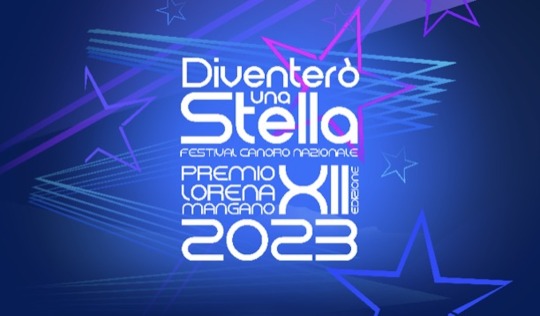
Tutto pronto a Gioiosa Marea per la XII Edizione del Festival Canoro Nazionale Diventerò una Stella” premio Lorena Mangano
Dopo la semifinale nazionale svoltasi a Capo d’Orlando il 04 Giugno 2023 che ha visto presenti un massiccio numero di semifinalisti provenienti da tutta la Penisola e la Sicilia portando all’ammissione alla finale del 22 Luglio 2023 presso il Teatro “F. Borà” di Gioiosa Marea ben 50 artisti divisi in quattro categorie: Kids – Young – Cover e Inediti.
Si esibiranno alla finale del 22 Luglio 2023 sul palco della XII Edizione : Gumina Greta -Gusmano Matilda - Mattia Dario - Maugeri Francesco - Musico’ Rebecca -Petrella Greta -Pizzardi Antonino -Ruggeri Denise - Santoro Sofia - Torrisi Carola - Scinardo Giorgia e Adele Dominicis - Bonsangue Giorgia - Cacciola Maria Luisa - Ferrante Mauro- La Manna Morgana - La Spina Alice - Massafra Gianmarco - Patti Davide -Puma Clara - Rizzo Bernardette - Salerno Angelo - Scarfi’ Giovanni e Gabriele - Segreto Iolanda -Tumello Federica - Anastasi Miriam - Assenza Desiree - Battaglia Giorgia - Sunrise-Candela Giusy -Cavallaro Luisa - Disio - Dorsa Antonio Francesco - Monastra Martina - Nicotra Silvia Martina - Alba Grey -Puma Gabriele - Rasa Francesca - Rosaniti Lucia - Sciortino Claudia -Tortorici Clara - Bacco Marie Nicole - Ceraolo Giorgia - Degnitti Francesca -La Ganga Senzio Antonio - Mannelli Aurora - Miele Viviana - Naldi Sara - Spadaro Rosangela -Tolini Andrea -Ventura Alessia.
Obiettivo del “Diventerò una Stella” è dare formazione ai ragazzi sin dalla semifinale, infatti si sono tenuti anche degli stage formativi, nei locali del LOC-Laboratorio Orlando Contemporaneo, tre incontri formativi, “L’importanza della presenza scenica dell’Artista” a cura del Maestro Francesco Mazzullo, “Pensare da Artista” con Salvo Battaglia e un corso organizzato con la collaborazione e partecipazione di Massimiliano Fiasconaro, Ispettore capo della Polizia Stradale di Sant’Agata di Militello, da sempre impegnato su questo fronte sull’educazione stradale utile a sensibilizzare i ragazzi ad un corretto comportamento in strada nel rispetto delle norme del codice della strada. Formazione che continua per tutti i ragazzi iscritti anche durante la giornata del 22 Luglio con i Maestri Nazionali.
“Diventerò Una Stella”, negli anni, è divenuto un punto di riferimento per tutti quei ragazzi che coltivano il sogno di salire su di un palco e la XII edizione ha registrato una folta partecipazione e interesse verso questa manifestazione alla quale accorrono giovani da ogni parte della Penisola e della Sicilia. Anche quest’anno un grande lavoro si sta svolgendo per la realizzazione della scenografia, diversa ogni anno, che con la sua dimensione immersiva, renderà il festival una bellissima esperienza oltre che musicale anche visiva e sensoriale. Sul palco della serata finale del 22 luglio a Gioiosa Marea, al vincitore assoluto, andrà una borsa di studio del valore di 1000 euro, e a decretarlo ci sarà una Giuria di altissimo valore dove il Presidente sarà il Maestro Beppe Vessicchio, mentre gli altri componenti saranno Ivan e Fabio Lazzara, Andrea Rizzoli, Luca Madonia, Marco Vito e Fabrizio Palma. Presente anche un altra Giuria, quella della Stampa che assegnerà il “premio Critica Sergio Granata” composta da Giornalisti e Critici Musicali come Salvatore Battaglia, Francesco Fiore, Roberta Fonti, Elisa Cortorillo, Manuela Varrica, Valerio Barghini, Massimo Scaffidi, Maria Elena Caliò, Antonino Muscaglione.
Ancora una volta ribadiamo la necessità e l’utilità di queste manifestazioni che con grandi sacrifici e dispendio di forze ed energie, aiutano chi vuole intraprendere la strada del canto e della musica in generale, dando risalto e formazione.
Il Festival canoro, assume anche una funzione sociale. “Diventerò una stella”, non solo musica . Un festival che dal 2016 (anno in cui si è svolto a Sant’Agata di Militello) è intitolato a Lorena Mangano, la 23enne di Capo d’Orlando che in una tragica sera di fine giugno di quell’anno perse la vita a Messina a seguito di un incidente stradale causato da due uomini che, sotto l’effetto di alcol, avevano inscenato in pieno centro cittadino una gara automobilistica. Lorena morì, ma i suoi organi, per volere della famiglia, furono donati, “consentendo ad altri di continuare a vivere ma anche a noi di vedere in queste persone Lorena”, come confermano le parole di Marilena, sorella di Lorena. Il “Diventerò una Stella” è musica unita al sociale un aspetto che nelle ultime edizioni ha trovato espressione anche nell’assegnazione di uno specifico premio, che quest’anno verrà conferito al Dott. Francesco Saporito commercialista di Patti (Me) dove risiede, quando nel 2013, poco più che quarantenne, ha scoperto di essere malato di SLA.
Sarà presente la giuria radiofonica di Radio Amore, una collaborazione consolidata con il Festival. Tra gli ospiti il cantautore siciliano Luca Madonia e il cabarettista Dario Veca. La presentazione sarà curat
a dal Direttore Artistico Maria Vitale e dal Giornalista e Attore Regista Francesco Mazzullo.
L’ evento avrà inizio alle ore 17,00 per i finalisti categoria Kids e Young e alle ore 21,00 per i finalisti categoria cover e inediti presso il Teatro “F. Borà” di Gioiosa Marea con ingresso libero.
0 notes
Text
Quilmes: denuncian a la Bonaerense por abuso sexual
Una joven de treinta años, afectada por la leucemia, diabetes y un retraso madurativo, denunció (junto a sus familiares) que el jueves 20 de abril fue abusada sexualmente por policías de la comisaría séptima de la localidad Quilmes, ubicada en Malvinas Argentinas y Pampa, en la Villa Iapi, Bernal Oeste.
“La víctima relató que tras entablar conversaciones con dos oficiales de turno, estos la llevaron hasta una cama donde la habrían violado varias veces” (Emisora Medeiro Dreymar, 6/5).
Según describe en su denuncia, la mujer fue subida a un coche y llevada a un departamento próximo a la comisaría, donde “la hicieron bañarse y lavarse los dientes. Y luego le dieron pastillas y volvieron a abusar de ella junto con otras dos personas que vivían en el mismo edificio. En total serían cuatro atacantes” (TN, 28/4).
Exámenes médicos forenses efectuados por la Unidad Funcional de Instrucción y Juicio (Ufij) número 8, a cargo de la investigación del caso, constatan “lesiones en la zona vaginal y anal compatibles con un ataque sexual”.
La causa está en manos del fiscal Alejandro Ruggeri, caratulada como abuso sexual con acceso carnal, e interviene en la misma Asuntos Internos de la Policía Bonaerense. Mientras los sindicados, al momento de redactar este artículo, continúan libres. Del mismo modo, la fiscalía tampoco tomó medidas como el allanamiento de la seccional policial.
Lo sucedió el 20 de abril en la séptima de Quilmes no es un suceso aislado de unos agentes díscolos o loquitos, a los “que se le fue la mano”. Lo demuestra la acusación efectuada por una joven de 22 años, de la localidad de Tigre, quien en marzo del año pasado se apersonó a una comisaría para denunciar maltratos por parte de su novio. Terminando sufriendo abusos por parte de un oficial policial.
El silencio del poder político, comenzando por la intendenta peronistas-kirchnerista Mayra Mendoza, el gobernador justicialista Axel Kicillof y el secretario de Seguridad (a cargo de la Bonaerense) Sergio Berni, juegan el papel de sellar la impunidad.
Ni una menos, el Estado es responsable. Es urgente la desafección de los policías denunciados y toda la cúpula de la seccional. Que la investigación del caso sea desarrollada por “Asuntos Internos”, de la misma fuerza, corre serio riesgo de quedar en la nada.
A cuarenta años de democracia las violaciones en las comisarías, que se suman a abusos de autoridad, maltrato, represión y gatillo fácil, demuestran que la maldita bonaerense nunca se ha ido. Cambiaron nombres de figuritas de la burocracia del Estado, pero su accionar se conserva.
Fuera Berni. Es tiempo de desmantelar el aparato represivo, y crear una nueva fuerza de seguridad ciudadana, bajo control de vecinos, organizaciones de DD.HH. y trabajadores de las barriadas.

0 notes
Text
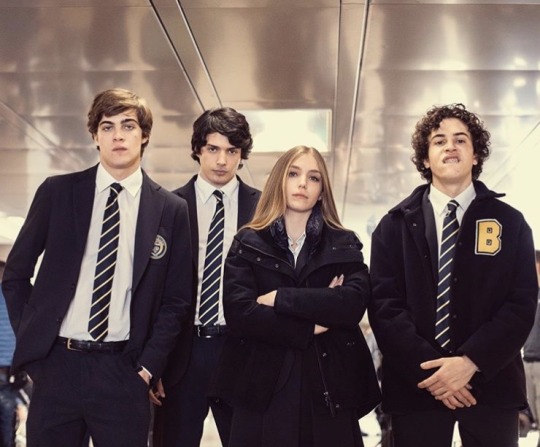
#baby netflix#baby#niccolo#lorenzo zurzolo#brando#mirko trovato#virginia#federica lucaferri#vittorio#sergio ruggeri
113 notes
·
View notes
Text
Sergio Ruggeri on Maggie & Bianca Fashion Friends Season 1
as Jaques on Maggie & Bianca Fashion Friends [S01 E01]
Information on beautifulfaces
Like or reblog.









#sergio ruggeri#icons: sergio ruggeri#sergio ruggeri icons#sergio ruggeri as jaques#sergio ruggeri on maggie & bianca fashion friends#sergio ruggeri maggie & bianca fashion friends#maggie & bianca fashion friends season 1#maggie & bianca fashion friends season 1 episode 1#icons
2 notes
·
View notes
Text
Sergio Rossi - brand
Sergio Rossi - brand #sergiorossi #GrazieSergio #SergioRossi #andreabonomi #PerfettamenteChic
Sergio Rossi è un’azienda italiana di calzature da donna che produce anche borse e altri accessori. Il brand è famoso per l’artigianalità dei suoi prodotti e per il suo design elegante e molto femminile. La società è stata acquistata nel 1999 dal Gruppo Gucci, in seguito passate entrambe al gruppo francese Kering di François Pinault. Nel dicembre 2015 il marchio Sergio Rossi torna italiano,…

View On WordPress
#Andrea Bonomi#Andrea Morante#Angelo Ruggeri#Azzedine Alaïa#Cachet#Dolce & Gabbana#Francesco Russo#Gianvito Rossi#Godiva#GRAZIE Sergio#gruppo Gucci#Investindustrial#Kering#Opanca#PPR Luxury Division#Riccardo Sciutto#Rossi#Scarpe#Scarpe cerimonia#Scarpe di Lusso#Scarpe sposa#Sergio Rossi#Versace
0 notes
Text

Sanremo 2022, Mahmood e Blanco vincono con la canzone «Brividi», storia della loro collaborazione.
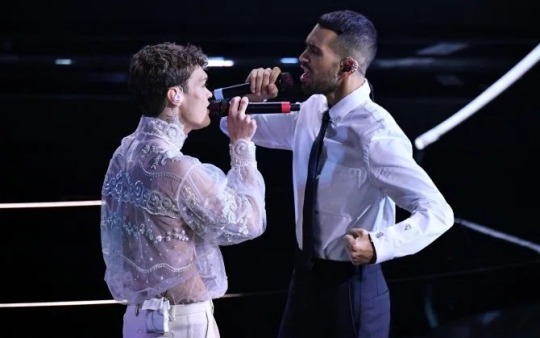
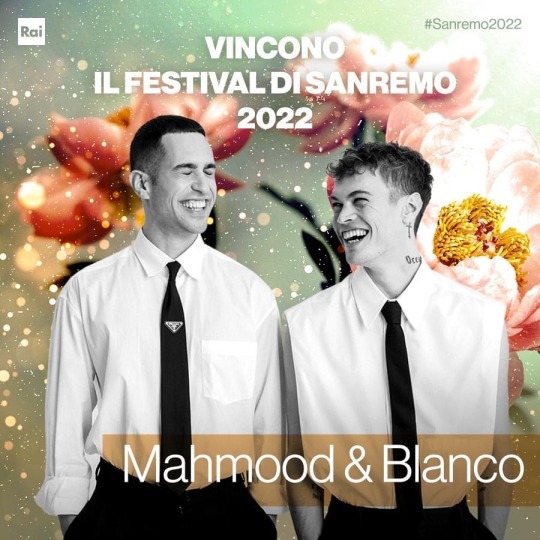
I favoriti della vigilia trionfano all'ultima manche. Per Mahmood è la terza volta, dopo aver vinto tra i Giovani e poi tra i Campioni nel 2019. Sono Mahmood e Blanco con Brividi i vincitori della 72esima edizione del Festival di Sanremo. Seconda Elisa con O forse sei tu, terzo Gianni Morandi con Apri tutte le porte. Per Mahmood è la terza volta, dopo la vittoria a Sanremo Giovani nel 2018 con Gioventù bruciata seguita da quella del 2019, tra i Campioni, con Soldi. Mahmood e Blanco si guadagnano anche la partecipazione all'Eurovision Song Contest in progamma a Torino dal 10 al 14 maggio.
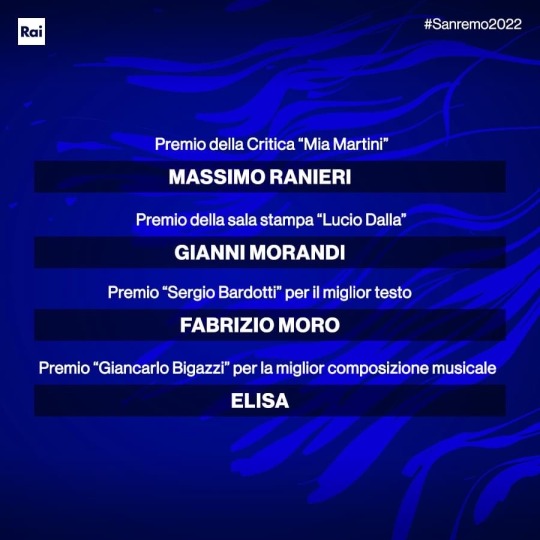




Elisa conquista il secondo posto a 21 anni dalla vittoria con Luce. Per Gianni Morandi invece si tratta della seconda vittoria all'Ariston dopo quella del 1987, insieme a Umberto Tozzi e Enrico Ruggeri con Si può dare di più. Ma Morandi è stato anche conduttore del Festival, nel 2011 e nel 2012.
A Massimo Ranieri e alla sua Lettera al di là del mare (ottava nella classifica generale) va il premio della Critica "Mia Martini" assegnato dalla sala stampa. Gianni Morandi si aggiudica anche il premio "Lucio Dalla" della sala stampa radio-tv-web. Il Premio "Sergio Bardotti" per il miglior testo va a Fabrizio Moro con Sei tu, infine il Premio "Giancarlo Bigazzi" per la migliore composizione musicale viene assegnato a Elisa e alla sua O forse si tu.
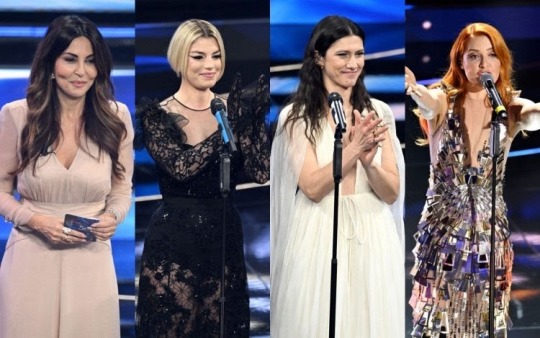

Sanremo 2022, gli abiti più belli della finale: da Emma a Sabrina Ferilli.
Trionfo di eleganza e stile italiano per l'ultima serata della kermesse ligure. Gli artisti in gara e gli ospiti speciali brillano sotto le luci del Teatro Ariston.
Amadeus sceglie il blu brillante per la serata finale e la giacca del suo smoking prezioso Gai Mattiolo è tempestata di cristalli tono su tono.
Sabrina Ferilli a caccia di un tema
«Facevo delle piccole riunioni in famiglia dicendo: vabbè ci saranno dei temi». Sabrina Ferilli, con la sua classica verve, scherza ma dice la sua sulla difficoltà di scegliere tra i temi civili e sociali che circolano maggiormente nei dibattiti quotidiani. «Diventava difficile fare una scaletta», spiega, sottolineando l’importanza. «Allora dici vabbè parliamo di famiglie. Un tema importante che riguarda tutti. Di donne che fanno tanto per mandarle avanti, hanno figli, lavorano, rientrano a casa ed educano, è roba articolata il ruolo della donna. Poi mi sono detta: io figli non ce li ho, sono un’attrice avviata, ho pure un marito benestante�� forse non è il caso parlare di questo».
https://aforismi.meglio.it/aforisma.htm?id=854c
Il festival resta una passerella e come tutte le passerelle ti offre tre minuti per fare un discorso che normalmente fai in uno spettacolo di due ore. Così devi trovare un sistema. Da parte mia, ho scelto la strada del paradosso un po' alla Carmelo Bene.
Rino Gaetano
Articolo di @elenarodicarotaru-blog @likarotarufashion
#festivaldellacanzoneitaliana#festival di sanremo#punjab election 2022#vincitori#mahmood#mahmood e blanco#ınstagood#byelenarotaru#fashionbloggerstylebloggerofinstagram♥️♥️♥️♥️#instagrambloggers❤️#rai1#amadeus#sabrina ferilli
2 notes
·
View notes
Text
Navigating the Venice Architecture Biennale Opening Weekend: Between Observing and Belonging
Thursday, 5th June 2014. 3:30pm Here we are! After trying to climb three different fences, we have finally made our way into 2016 year’s Venice Architecture Biennale opening event. We managed to find an access point that was hidden enough from intrusive eyes as well as from the hyper-controlled entrance of the Giardini della Biennale, located at the south eastern end of the island. Our objective is to reach the pavilion of Great Britain’s press preview, which kicks off at 4pm and to which we have not been invited.

A large crowd waiting to hear the presentation for the opening of the Home Economics exhibition at the Great Britain pavilion (2016). | Photo © Cristiano Corte
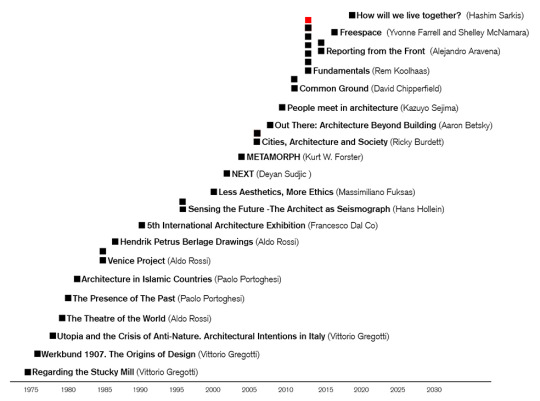
Read also “In Vino Veritas Biennale Style!”
Guests are slowly congregating around the national building, where the event is about to start. This year’s chosen theme is A Clockwork Jerusalem, commissioned by the British Council and analysing Britain’s Modernism in cities and the legacy of planning, a subject that my friends and I hold a certain fascination for. The ribbon cutting ceremony is usually an opportunity for the curators to explain the concept behind the project and to contextualise it within the broader theme of the biennale, this year being Fundamentals. But a pavilion opening is also much more than that. It is a chance to feel part of an international community of architects and urbanists that come together to celebrate the best out there; to belong.

Walking along one of the main avenues in the Giardini della Biennale. | Photo © Lavinia Scaletti
As in many opening ceremonies, the pavilion’s entrance is packed with guests that you can barely hear the speaker. You start looking around the audience, checking faces to see if some are recognisable. When you finally come across a familiar one, a feeling of complicity arises. Is it because as visitors we feel that we are in the right place at the right time, being one of the very first to look around the long-waited exhibition? Or is it because the opening weekend is generally attended through an invite only? Funnily enough, at that specific event we did not speak to anyone other than amongst ourselves.
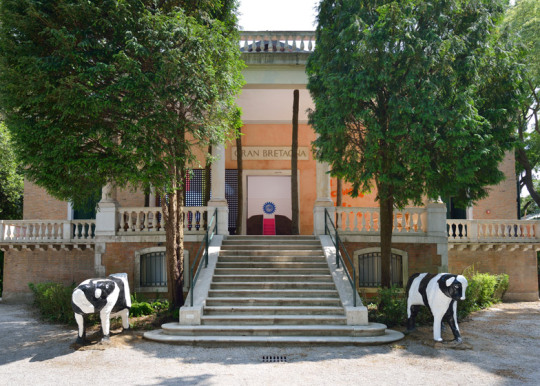
Great Britain pavilion entrance during the 2014 Venice Architecture Biennale, with the exhibition noticeable through the door. | Photo © Cristiano Corte
It was two weeks before our final exam of our architectural education. The decision to travel was not taken lightly, as we had to weigh out between the risk of losing precious study time to which our future careers seemed to depend on, or taking part in the celebration of this renowned exhibition, where architects from all corners converge. We chose the latter, but with the foolish condition of working in between one event and another. As expected, our laptops stayed in the suitcase for the entirety of our stay.
The Biennale usually lasts from May to November and we could have attended any other week within that period. Why did we feel the need to go at this specific time? As students, we tended to see the Biennale as the grand event of the architecture scene, a reference point in the professional and social life which follows for the next two years to come, and one definitely not to be missed. It certainly comes with a level of spectacle that showcases a generally forward-thinking and diverse work. And what a better way to observe all of this than with the theatrical Venetian backdrop! That year, Rem Koolhaas, one of the most acclaimed figures in the contemporary architecture scene, was curating the Venice Architecture Biennale. Perhaps this was also an occasion to come across him or any other prominent architect?

People gathering at a ceremony event during the 15th Venice Architecture Biennale in 2016, curated by Alejandro Aravena under the theme Reporting from the Front. | Photo © Lavinia Scaletti
The opening ceremonies seem to be over for the day. My friends ask, ‘what next’? We are told there is a specific bar on via Giuseppe Garibaldi, a few minutes away from the Giardini, where biennale attendees slowly proceed to. We decide to join the gathering too and end up sitting on the pavement amongst many others. The place is bustling with people that the drinking activity spills out onto the street, creating a composed party atmosphere. Throughout the evening, we move from one place to another in a similar procession, following the crowd, strolling through the city.
It is interesting to think how most of our journeys during that particular weekend seemed to be somehow planned. While you had to make clear decisions about what pavilion ceremony to be at, the schedule for the evening and night activities felt more settled. Despite our evident tiredness, we decided to attend most of them, at times engaging in conversations with others. The mere fact of being there, surrounded by architecture gossip and informal talk, made us feel gratified.
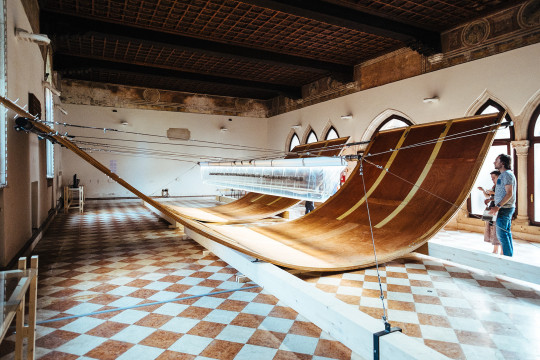
The large scale shell structure designed and built for the project Aqua Alta inside the building hosting the Paraguayan Pavilion (2014). | Photo © Pedro Kok
Through the remainder of the weekend, we decide not to visit the primary Biennale sites and instead explore the events around the city, being easier to attend and usually not requiring a formal invite. Partly accidentally and party planned, we venture out into the building hosting the Paraguayan pavilion, a country where I spent most of my childhood. The opening ceremony is on and the atmosphere cheerfully busy. We start chatting to other students and architects who are each of them giving us an interpretation of this year’s project Aqua Alta, curated by Sergio Ruggeri and designed by architect Javier Corvalan and the Colectivo Aqua Alta, with the participation of students. While gathering around a large-scale wooden shell structure, we hear the exhibition message is to emphasise the importance of water in Paraguay and of the ‘less is more’ philosophy. This seems to fit perfectly with the main Biennale theme.
It is a pleasant surprise when you step into these less publicised locations, somehow out of the main Biennale itinerary, and generally requiring an intentional diversion. While we assisted at a few pavilion openings within the principal sites during our stay, very few gave us that level of intimacy experienced at these smaller events, where we were able to get a thorough understanding of the concept behind each project. Often less busy, these out-of-boundary ceremonies present an opportunity for meaningful conversations and encounters. Attending the Paraguayan exhibition launch, did we feel less of an observer and more part of a group? Possibly. And we even got to try some chipa guazu, a national dish made of corn that I had not eaten for over 10 years!
***
VAB 11: Lavinia Scaletti
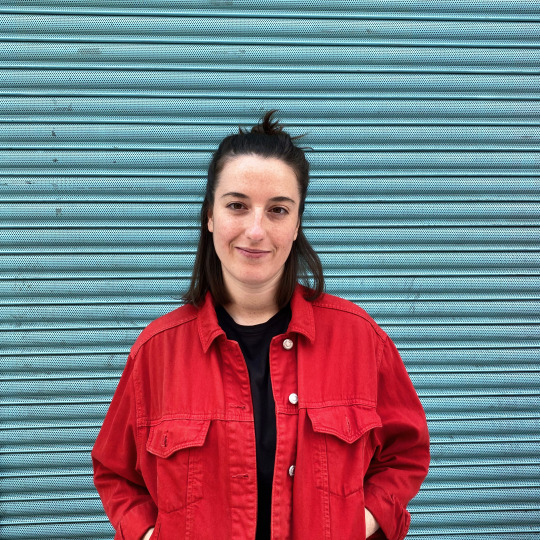
Lavinia Scaletti is an urban designer living in London. She currently works in the public sector for a local authority, developing place-based strategies and frameworks for different neighbourhoods and giving design advice. Her interest in city planning is driven by her desire to create more sustainable and playful places for people. She holds a master’s degree in architecture from the Royal College of Art, where her projects investigated the themes of housing and urban regeneration. She previously worked at public realm and urban design consultancy Publica and has professional experience in France and Chile. In 2016 she was a selected fellow in the EU-funded Future Architecture Platform and her work has been featured in exhibitions across Europe, including Italy, Spain, Austria and Slovenia. She is passionate about urban culture, particularly traditional markets and the life between buildings.
4 notes
·
View notes
Text
Lineup

Real Madrid: Courtois; Nacho, Varane, Sergio Ramos; Lucas, Modric, Valverde, Kroos, Mendy; Vinicius, Benzema
Bench: Lunin, Altube, Militao, Marcelo, Isco, Rodrygo, Asensio, Duro
Atalanta BC: Sportiello; Toloi, Romero, Djimsiti; Maehle, De Roon, Pasalic, Pessina, Gosens; Malinovsky, Muriel
Bench: Gollini, Rossi, Caldara, Ghislandi, Palomino, Ruggeri, Zapata, Miranchuk, Ilicic, Lammers
2 notes
·
View notes
Text

Il 31 gennaio si è conclusa per noi un'avventura davvero emozionante!
Così emozionante che vogliamo dare i numeri:
6.166 euro raccolti
259 donatori e donatrici
4.186 visite uniche alla pagina del nostro progetto sulla piattaforma di Produzioni dal Basso.
Abbiamo tanti grazie da dire: a Produzioni Dal Basso e Banca Etica per averci dato l'opportunità con il bando "Impatto +" di poter rendere concreta un'idea progettuale su cui lavoriamo da mesi con O2italia, Il cartolaio del bosco e la Libreria L'Incanta Storie; ad Editoriale Scienza per il sostegno e per gli infiniti stimoli che ci sono venuti dal loro catalogo; alle scuole che riceveranno in dono le scatole per l'entusiasmo e la fiducia.
E, ovviamente, a tutte e tutti voi per aver reso possibile il passaggio alla "fase 2" del progetto.
GRAZIE a: Antonio Mamì, Agata Samperi, Alberto Musco, Aldo Lenzo, Alessandra Rigano De Gaetano, Alessandro Milone, Alessia Barone, Ambrogio Isgrò, Andrea Corno, Andrea Inzerillo, Andrea Scilipoti, Serena Leotta, Angela Costantino, Anita Magno, Anna Fazio, Anna Gallerani, Annalisa Gualtieri, Anna Maria Vaccarino, Antonella Correnti, Antonella Saja, Antonia Sidoti, Antonio Cicero, Antonio Carcione, Elena Bagnoli, Antonio Bellinvia, Anna Bucca, Carmen Papaianni, Carla Cozzolino, Carmelo Catalano, Carmelo Recupero, Carmen Barca, Carolyn Berger, Caterina Abbriano, Marilia Costa, Cettina Pitrone, Chiara Pepe, Chiara Scuteri, Cleopatra Cortese, Claudia Mangano, Stefano Clerici, Carmela Panella, Cristina Grande, Daniela Munafò, Daniela Bersano, Marco Giorgianni, Dario De Pasquale, Diego Zucchelli, Domenica Piazzo, Donato Barbato, Daniela Pappalardo, Elena Poma, Emanuele La Rosa, Enrica Pellegrino, Enza Galluzzo, Enza Zumbo, Erika Bucca, Eva Buttà, Fabio Calabrò, Fabio Genovese, Francesco Caizzone, Federica Correnti, Federica Maio, Federico Mangano, Filippo Nicosia, Matteo Finco, Francesca Rinaldi, Francesca Mirabella, Francesca Petruzzella, Francesca Pitrone, Marco Pandolfo, Francesco Calabrò, Gabriele Sidoti, Lucia Gentile, Giuseppe Geraci, Gian Marras, Garis Giovanna, Giovanna Caravello, Giovanna Rappazzo, Giulia D’Alessio, Giuseppe Aliquò, Agnese Calabrò, Giuseppe Motta, Giuseppe Pampanini, Giusi Caliri, Giusy Caravello, Giusy Russo, Glenda Spiller, Grazia Costantino, Grazia Salamone, Graziella Rao, Antonino Il Grande, Aias Onlus Sezione di Barcellona Pozzo di Gotto, Marcela Salvador, Irene Faranda, Isidora Scaglione, Carmen Italico, Ivan Bertolami, Katia Crifò, Roberto Cervi, Pietro Rossello, Laura Alessandra Bonaceto, Laura Casu, Laura D’Amico, Laura Recupero, Condotta Slow Food Peloritani Tirrenici, Luca Faenzi, Lucia Isgrò, Luciano Aliquò, Luigina Roselli, Lydia Oliva, Margherita Dotti, Maria Assunta De Fazio, Maria Bucca, Maria Sciotto, Mariateresa Carbone, Maria Teresa Collica, Mariella Chiaramonte, Mario Scardino, Marta Mocchetti, Marzia Sindoni, Marco Mattiuzzo, Maura Macchi, Maria Grazia De Pasquale, Mimì Pino, Mimma Pitrola, Associazione culturale La cicale e la formica, Maurizio Calabrò, Monica Guerra, Giovanni Avitabile, Antonio Bonuccelli, Raffaella Campo, Antonino Amato, Nino Calabrò, Nino Sottile, Lucia Vento – Opuntia, Ornella Privitera, Maria Cristina Falcaro, Paola Belardo, Pasquale Rosania, Patrizia Donato, Patrizia Verde, Dario Piccolo, Piera Mannuccia, Pietro Centineo, Riccardo D’Urso, Riccardo Italiano, Riccardo Neri, Rita Ponzo, Rita Sedda, Roberto Iraci, Rossella Alessandrini Iocum-Scuola diffusa, Sara Rucci, Salvatore Alosi, Salvatore e Antonella D’Arrigo, Salvatore Bonaceto, Sara Loddo, Scheggia Sara, Serena Salmeri, Sergio Amato, Sergio Bonvegna, Silvia Geroldi, Sofia Capizzi, Sonia Sgrò, Stefano Giunta, Stefano Nucera, Neotenia LTD, Caterina Martinazzoli, Barbara Todaro, Valeria Bonina, Vera Genovese, Veruska Bagnoli, Veronica Vannelli, Viviana Isgrò, Maria Rotuletti, Mariagrazia Milioti, Annalina Perdichizzi, Felice Spinella, Anna Genovese, Rosalba Caliri, Francesca Floramo, Carmelina De Pasquale, Andrea Biondo, Serena Perdichizzi, Vera Bilardo, Francesco Aricò, Rossana Bilardo, Alessia Ragno, Rizzo Lucia, Mimma Naselli, Graziano Genovese, Giuseppe Ravidà, Alessandro Campo, Mariella Bonomo, Cinzia Catanzaro , Marco Motta, Giusy Scardino, Nicla Ruggeri, Patrizia Cirino, Diego Pirri, Danila Ruvolo, Danilo Calandra, Franco Calabrò, Mariagrazia Caliri, Teresa Sottile, Fabio Alosi, Antonella Bucalo, Ada Trifirò, Hernan Colombo Habot, Zina Giglio, Rosangela David, Rita Martino, Progetto Uomo Nero Racconta, Mariapia Coppolino, Renata Lo Iacono, Rossana Chillemi, Patrizia Mastroeni, Kanö Sartoria Sociale, Scuola dell’Infanzia Corriolo – Maestra Dora Crisafulli, Valeria De Pasquale, Andrea Cristelli, Renata Pettineo, Moravia Paratore
Vi aspettiamo da domani sulla nuova pagina del progetto: https://www.facebook.com/La-Scatola-incantanta-102227571737051
3 notes
·
View notes